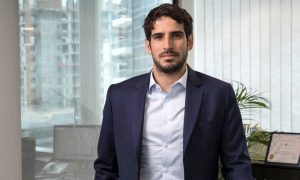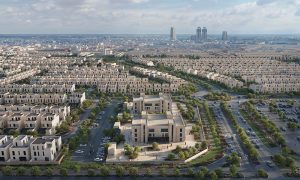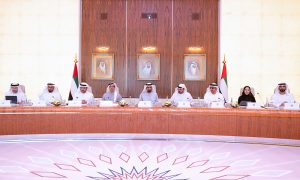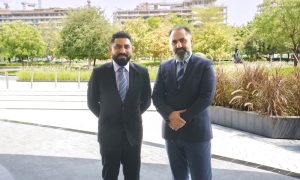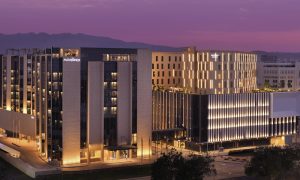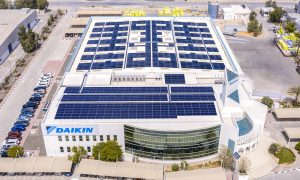All About Aluminium
The Big Project brings together three aluminium experts at the Media Rotana Dubai to discuss developments, opportunities and weaknesses in one of the GCC’s most lucrative industries

What are the key strengths in the aluminium industry in the Middle East region?
Modar Mohamed Al Mekdad (MM): Having cheap energy is one of the key elements in this industry. To produce one ton of aluminium you require 15,000kw of electricity, therefore it’s natural to be located here.
Phil Ellerby (PE): We specialise in aluminium envelope solutions for buildings. We tend to be involved in the higher-end projects like airports and there are currently many airport contracts in the region.
MM: In the last five years, the region has witnessed a boom in primary production. The downstream industry consumes 16% of this, with the rest exported.
If you add value in terms of extrusion, flat roll products, building influx, finished products add a lot to the region in terms of GDP. When we talk about US $55 billion investments and how much it can be inflated on the downstream side; up to multiples of 10 or even 20.
[facts]
The Panel:
Modar Mohamed Al Mekdad, General Manager, Gulf Extrusions
Phil Ellerby, Managing Director and Owner, Rigidal Industries
Tarek S Ali, Show Manager,Reed Exhibitions;
organisers of Aluminium Dubai
[/facts]
What are the potential weaknesses you have identified in the market?
MM: You need government involvement in projects. There are not many varieties of products, just rods and billets; downstream production requires investments in technology, R&D and establishing a technology-based industry rather than just converting from aluminium shapes.
For this reason we diversified our operations into automotive, transportation, electrical and machine parts. As a result, I can say now that that decision helped us to overcome the recession.
If you allow more imports to come in there will always be the contractors only buying on the basis of price”
PE: Sadly, we’re a little too remote from the primary producers of ingot billet and slab. For us to be able to utilise aluminium in our own envelope solutions there needs to be another interface, which is the hot rolling mill, producing coil. There is only one real producer in the Gulf states at the moment, which is based in Bahrain.
MM: We have conducted feasibility studies which concluded that without government support in terms of natural gas, liquid metal and energy tariffs, projects are less viable.
Also what scares me in the Middle East is the lack of communication between upstream and downstream industries.
[facts]
85%
Predicted level of exported aluminum from the region’s plants by 2030
[/facts]
What seminal events occurred to help the evolution of the industry over the last decade?
MM: When the boom began around 2002, demand was around 50,000 tons per annum and available capacities were higher in supply than demand. In 2005, the market demand reached approximately 100,000 tons and metal began flowing in from India and China.
In 2007, it was said demand had surged to around 180,000 tons per annum simply because of the pace of construction. But in the absence of clear statistics this data misled many investors and today 50% of factories are running at 50% of their capacities.
PE: That scenario was paralleled in most of the Gulf industries, but especially in the UAE. There is a huge amount of overcapacity now because investors were ill advised. Across the entire construction kaleidoscope, there was over capacity because people were investing in downstream industries and there wasn’t a market to support it in the long term.
How have these events shaped the industry today?
PA: When you have an overcapacity in the marketplace like we do now — whether it’s extrusion or it’s a finished tertiary product — it results almost automatically in lower, unsustainable prices. There is so much overcapacity at the moment that anybody who invested in the last five years is now trying to keep their company alive, reflected directly in the sales price.
TA: Price fluctuations may be to the advantage of some investors, but we can probably encourage more architects to invest in aluminium. It is happening for new buildings, but what about the old buildings? There is potential in the retrofit market as well as the new build.
MM: Established companies can be more patient; in the UAE quality standards are very high and I believe we are seeing greater demand for certain specifications not every company can meet. I believe in another three-to-four years the situation will balance out.
How does the lack of codified regional standards impact on production and supply?
MM: Architects implement UK, American, Japanese or Australian norms. The problem when you have so many different standards is that sometimes you might over or under specify because you don’t know what is applicable for the region. As the chairman of Qualico, we are trying to enhance quality and influence how standards are set through working groups.
Local government on a federal level should work on establishing proper standards to cover investors; we need local standards especially for imported material or in-house manufacturing.
PE: Having been here 30 years and coming from England, we use British standards. They are the longest-standing and most comprehensive. Standards from Germany are good and there are many from America; some relevant, others not. But it is essential to have standards fit for purpose for the area in which you are working. Europe requires high PVDF coating for UV protection, whereas the Middle East has a lot of sandstorms so we use a polyamide modified polyurethane coating system.
How does the demand for standards change within the industry and between different end users?
In the private sector, if it is a build-and-operate project they really demand good quality, but in build-and-sell, quality is not a key issue”
PE: If you are working with people who are the decision-makers and ultimately the client, or their technical advisors who are there to put together a fitting specification for a project, then people are very interested in quality. The remit is given and it’s up to the consultants and architects to write the standards.
They have won a project based on a quotation and a certain level of specifications and they are rarely interested in improving those specifications if they are there to make a commercial profit. If one is to improve specifications generally then it is through clients’ representatives in a private investment or through the various government departments; any of the institutions which are building high levels of infrastructure that they want to last.
MM: Dividing public and private projects, government projects demand high standards, but what happens is that when the project is executed we find a gap between specifications and actuality. We have seen in many government projects certain certifications are insisted upon for certain products but then for other products they are not developed.
In the private sector, if it is a build-and-operate project they really demand good quality, but in build-and-sell quality is not a key issue. They just want to make a reasonable price.
Again there is the awareness of quality that is still to be developed in this part of the world. If I look at the tender document from the specification point of view versus what is actually being supplied we see sometimes we have a gap, especially when you talk about schools or low-cost housing.
We also need to develop quality control; even in low-cost housing there are specifications to be met. The government pays for a good-quality product, where is this gap? Which pocket is it going to? At the end of the day, some of the products are of inferior quality. Projects need quality-control consultants to be appointed by the client, so part of this chain is missing somewhere. I’m not expecting the developer or client to know everything about the products, but there are specialists who know what quality should be.
There should also be supervision from the government to say this is the minimum that should be met for a particular industry or product. This is where we are yet to catch up.
TA: In exhibitions today, the machinery and processing equipment profiles mostly come from the European market, which shows there is a quality in the production process, not only in the primary side.
For example today 65-70% of exhibitors come from the processing and machinery fields and the machines from Germany or Italy, reflecting the quality of the products coming from this machinery.
I think the Gulf Aluminium Council (GAC) brings expertise by tying up with associations from the UK and Germany promoting quality production. Progress is moving but not fast.
Could the introduction of more stringent building, sustainability or waste-management codes address the issue?
[facts]
$55b
Estimated investment in the region’s smelter expansions and new projects by 2020
[/facts]
MM: The existing codes have to be extended in detail for windows, doors and external envelopes, saving energy and green solutions.
Gulf Extrusions has a particular product, the thermal-brokered windows and doors, which can minimise the thermal transfer by 25 to
50%, yet the specifications are mandatory only in Sharjah, UAE.
TA: Maybe we could go back to the specifier to educate them and use the media as well as an educational channel.
MM: There should also be a code for the building. Today I want to buy an apartment, but I don’t know what is hidden under the tiles and false ceiling. There should be somebody to rate this building.
TA: The collection process in the Middle East region is not developed very well. The way people are not educated in how to separate the cans and re-use aluminium. So maybe aluminium is green, but people must be educated.
PE: I have my own personal theory that the UAE is inundated with vast numbers of extremely poorly-paid workforce. If you were to financially incentivise individuals or teach people how they can recycle cans, I think you would solve all the solid-waste problems of the Middle East overnight. I think unfortunately the exceedingly low-paid workers here don’t understand that.
There have been recycling facilities here in the UAE for a very long time; Union Paper Mills has got to be in excess of 30 years old. Lucky Recycling for aluminium in Jebel Ali has been operating for at least 25 years. The facilities are there. The great thing with aluminium is that it can all be recycled.
What are the overriding concerns in the industry?
TA: As an exhibition company we can bring any concept here, but we try to work slowly with the industry and are involved in massive market research to cover the region; focussing on innovation, applications and investment opportunities. We try to find opportunities for small and medium-sized investors to help develop the role of the industry and meet exhibitor demand.
Quality is also considered. We have Chinese companies coming to our exhibition and we need to understand exactly what conflict this can create in a small market place.
Are there any minimum quality requirements for exhibitors?
Price fluctuations may be to the advantage of some of the investors but we can probably encourage more architects to invest in aluminium”
MM: Today, when I exhibit I see low-quality companies and this can be harmful for us.
PE: It’s always a problem with exhibitions; the ones who want to exhibit are those who haven’t been here for 30 years developing and growing a business. They want the quick solution to be in the marketplace and so go to exhibitions to hand out hundreds and hundreds of cards.
TA: From the visitor’s point of view, they have the right to see what is cheap and what is expensive. It’s filtering; the size of the stand affects the visitor’s perceptions and secondly, you will be immediately identified as a quality provider in the region just by being present with your team.
[facts]
76%
of the aluminum produced in the Middle East is exported in its primary form.
[/facts]
MM: How do you verify the companies? Sometimes they are just trading companies representing Chinese companies; not even producers yet still classified as manufacturers. Today, somebody who is trading in extrusion is not an extruder. He will claim he is and will exhibit as one but how do you verify? I know the biggest companies in China will not accept small stands.
TA: We approach the companies and categorise. When we receive an enquiry the first thing is to ask them the products they deal in and what they manufacture.
MM: Around 80% of those companies exhibiting at exhibitions like this, throughout the region, are representing companies and not representing the manufacturers.
There is a problem with Chinese companies communicating, particuarly in new markets, so if you have the opportunity to solve this through trading companies you have the opportunity to represent massive companies in the region.
PE: In some cases the traditional methods used by Chinese, Korean and other Eastern companies are to establish trading companies.
When Korean companies first entered the market, they all sold through trading houses as a natural way of selling.
They will always pose a threat to the industry here, especially with this overcapacity situation. If you allow more imports to come in there will always be the contractors only buying on the basis of price and not quality.
There is a certain quality a company will accept, based on reputation. For example, we don’t buy from China at all, for a variety of reasons, despite the fact that the prices offered by these companies may be up to 20% less. At this stage their quality isn’t up to par.
What business strategies did you employ during the downturn?
PE: We had to improve product specifications and move on.
Now we are exporting our systems to other Gulf states, North Africa and India because of the massive drop in demand in the UAE, specifically in Dubai. But our new markets are now accepting a higher grade of specification than perhaps they have done in the past.
The envelope solutions we offer mirror the very best in the western world. Our initial and simplistic systems were then emulated by many of our market competitors, meaning we have had to improve those specifications and move on, again emulating the best.
We are seeing the excellence of Dubai and the UAE spilling out into the other Gulf areas with higher levels of specification. We don’t believe those specifications would have been there five years ago, but they certainly are now and the level of specification is improving all the time.
MM: There is added value in the downstream industry so we have diversified. For example, smelting adds $150, extruding $250, building a window adds maybe $500, selling and installation another $500, so you’re talking about $1100 added on the original price and there are many processes involved in that downstream.
Today we supply to Jaguar, Aston Martin, Lotus, Range Rover and Land Rover. We are going to put another extrusion plant in Abu Dhabi for non-architectural applications, investing around $300 million. India is one of the other areas we are expecting growth.
This shows you well established companies always have continuous growth. Of course, when there are financial problems we slow down but we don’t cancel.
We have taken advantage of the situation because for example, if today I want to buy an extrusion line I know that I can get it 30 to 40% cheaper than I could have done five years ago; my cost per square metre is much less than it was in 2005.
Facts
• 76% of the aluminium produced in the region is exported in its primary form
• 85% of Middle East aluminium is expected to be exported by 2030
• One ton of aluminium requires 15,000kw electricity
• The region is expected to contribute about 15% of the total global production of aluminium by 2015
• The Middle East Region is Currently Challenged by the Minimal Existence of the Aluminium Downstream Industries
• Saudi Arabia and the United Arab Emirates are among the Gulf’s two biggest aluminium markets
• 1.8 million tons is produced anually by Dubai Aluminium Company (DUBAL) and Emirates Aluminium (EMAL)
• This equates to 40% of the total Middle East production
• US $30b is the estimated current investment in the Gulf’s industry
• $55b is the predicted level of investment expected by 2050



